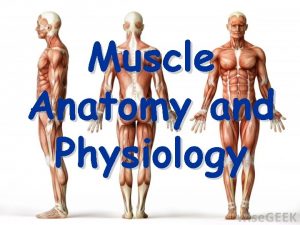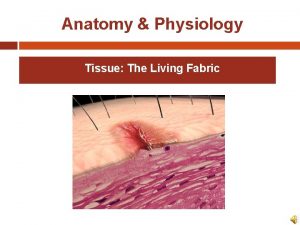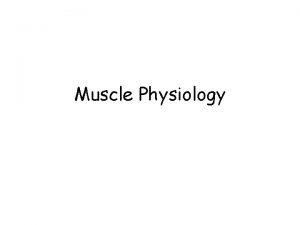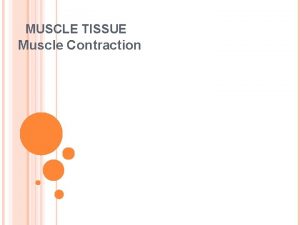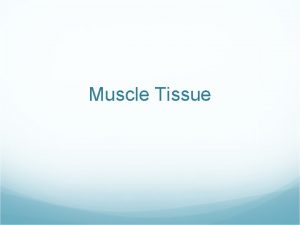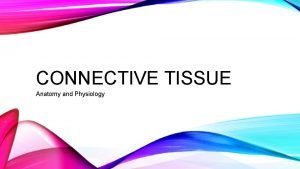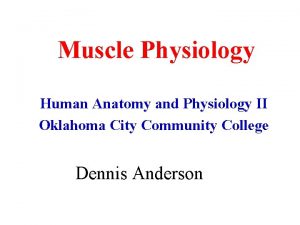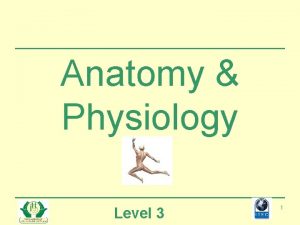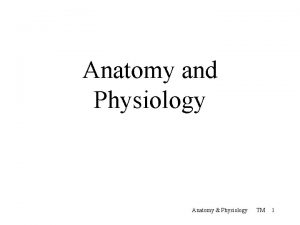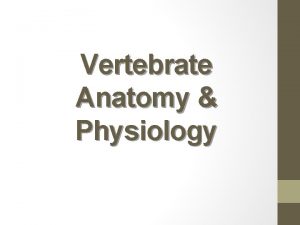Muscle Anatomy and Physiology Muscle Tissue Muscle Tissue



































- Slides: 35

Muscle Anatomy and Physiology

Muscle Tissue

Muscle Tissue • same brief description as tissue chapter • ½ of body mass • able to convert ATP (chemical energy) to mechanical energy

1. Cardiac Muscle • in heart only • striated and branching • involuntary

2. Smooth Muscle • visceral – – GI tract walls, – urinary bladder, – bronchi, – arrector pili, – iris

2. Smooth Muscle • smooth spindle shape • involuntary • contractions are slow and sustained without fatigue

2. Smooth Muscle • cells are surrounded by connective tissue - endomysium • usually arranged in sheets running in different directions

3. Skeletal Muscle • • make up the skeletal muscles striated (banded) voluntary muscles respond rapidly but fatigue easily

Functions of Skeletal Muscle

Functional Characteristics of Skeletal Muscle 1. contractibility - shortens with force 2. excitability - responds 3. extensibility - stretches 4. elasticity - recoils

Function of Muscle 1. Movement 2. Posture maintenance - continuous tiny adjustments 3. Heat generation - by product of metabolism – – nearly ¾ of energy released from ATP escapes as heat skeletal muscle is at least 40% of body mass

Structure of Skeletal Muscle


Structure of Skeletal Muscle • entire gross structure covered by connective tissue - epimysium • muscle is made of small bundles called fascicle which are bound by perimysium • each fascicle is made of a bundle of muscle cells or fibers which are surrounded by endomysium (all coverings are continuous extensions)


Muscle Fiber Structure


Muscle Fiber Structure • sarcolemma – muscle fiber plasma membrane • sarcoplasm – muscle fiber cytoplasm, contains myoglobin – a red pigment that stores oxygen • Each muscle fiber is made of bundles of rod-shaped structures of myofibrils (organelles). • (100’s to 1000’s per cell)

They have repeating pattern of striations called sarcomeres

The banding is caused by an orderly overlapping arrangement of protein filaments - myofilaments

Myofilaments: 1. myosin - thick, extend entire length of A band 2. actin - thin, extend across the I band part way into A band

• Z line - attachment site for actin, ends of sarcomere • I band - light bands, actin only • A band - dark bands, myosin and actin overlap

• • H zone - only visible in relaxed, myosin only M line - sarcomere center

Structure Connective Tissue organ Epimysium surrounds Perimysium tissues Endomysium surrounds cells organelles molecules Gross muscle Fascicle (bundles of cells) Muscle fiber (muscle cell) Myofibril (contracting organelle) Myofilaments Actin – thin filament Myosin – thick filament

Connective Tissue Epimysium Perimysium Endomysium Structure Gross muscle surrounds Fascicle (bundles of cells) organ tissues Muscle fiber cells Myofibril organelles (muscle cell) (contracting organelle) Myofilaments molecules Actin – thin filament Myosin – thick filament

Molecular Structure of Myofilaments


Myosin • rod like tail or axis ending in 2 globular heads - “crossbridges” - heads contain ATPase tail heads (enzyme)

Actin • globular subunits - G actin are found in long strands, like a double strand of twisted beads

Actin • tropomyosin spirals around beads, to add strength and stiffen, thin ribbon • troponin molecules bond actin to tropomyosin, has binding sites that will join with myosin crossbridge Binding sites


Sarcoplasmic Reticulum

Sarcoplasmic Reticulum • smooth endoplasmic reticulum of muscle cells • storage area for Ca ions • At H zones and A - I junctions tubes fuse and form lateral channels - terminal cisternae which feed into transverse tubules (T tubules) tubules at each Z line. • T tubules receive nerve stimuli and provide a pathway for oxygen, glucose, and Ca ions. (because continuous with membrane, nerve impulse allowed deep into muscle)


The End
 Pulmonary tract
Pulmonary tract Tattoo anatomy and physiology
Tattoo anatomy and physiology International anatomy olympiad
International anatomy olympiad External parts of a leaf
External parts of a leaf Anatomy and physiology bones
Anatomy and physiology bones Ulcer anatomy
Ulcer anatomy Liver anatomy and physiology
Liver anatomy and physiology Epigastric region
Epigastric region Epigastric vs hypogastric
Epigastric vs hypogastric Google.com
Google.com Chapter 14 anatomy and physiology
Chapter 14 anatomy and physiology Endomysium
Endomysium Http://anatomy and physiology
Http://anatomy and physiology Waistline
Waistline Appendicitis anatomy and physiology
Appendicitis anatomy and physiology Aohs foundations of anatomy and physiology 1
Aohs foundations of anatomy and physiology 1 Aohs foundations of anatomy and physiology 2
Aohs foundations of anatomy and physiology 2 Anatomy and physiology of swine
Anatomy and physiology of swine Anatomy and physiology chapter 8 special senses
Anatomy and physiology chapter 8 special senses Chapter 13 anatomy and physiology of pregnancy
Chapter 13 anatomy and physiology of pregnancy Unit 26 agriscience
Unit 26 agriscience Science olympiad anatomy and physiology 2020 cheat sheet
Science olympiad anatomy and physiology 2020 cheat sheet Chapter 2 basic chemistry anatomy and physiology
Chapter 2 basic chemistry anatomy and physiology Stomach anatomy and physiology ppt
Stomach anatomy and physiology ppt Anatomy and physiology of pancreas
Anatomy and physiology of pancreas Chapter 7:9 lymphatic system
Chapter 7:9 lymphatic system Chapter 14 the digestive system and body metabolism
Chapter 14 the digestive system and body metabolism Chapter 10 blood anatomy and physiology
Chapter 10 blood anatomy and physiology Aohs foundations of anatomy and physiology 1
Aohs foundations of anatomy and physiology 1 Aohs foundations of anatomy and physiology 1
Aohs foundations of anatomy and physiology 1 What produces bile
What produces bile Anatomy and physiology chapter 15
Anatomy and physiology chapter 15 Cornell notes for anatomy and physiology
Cornell notes for anatomy and physiology Human anatomy & physiology edition 9
Human anatomy & physiology edition 9 Necessary life functions anatomy and physiology
Necessary life functions anatomy and physiology Holes anatomy and physiology chapter 1
Holes anatomy and physiology chapter 1




































